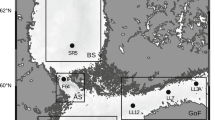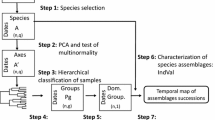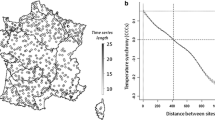Abstract
In recent regime shift analyses, the phytoplankton compartment of the marine food web was essentially represented by phytoplankton color or chlorophyll concentration. A detection of changes directly at the species level is highly desirable. The Helgoland Roads data series, a collection of high frequency long-term time series comprising biological and physico-chemical components of the southern North Sea, allow such an investigation at the level of single species. Aiming at a detection and characterization of habitat and community changes in the observation period (1962 until the end of 2008), we selected six species as representatives of certain classes, for example, benthic or neritic species, and applied a combination of novel analysis methods—a fitness-based analysis of the realized niche, a bloom-triggered averaging and a Markovian analysis of co-occurrence and succession patterns—to related abundance time series and concurrent environmental parameter time series. We found a general trend toward enlargement of niche size and shifts of the niche position, interesting salinity patterns around bloom events of two species, and statistically highly significant changes of a phytoplankton community segment after 1965 and after 1998. Interpreting our observations in ecological terms leads to the formulation of testable hypotheses.









Similar content being viewed by others
References
Bauerfeind E, Hickel W, Niermann U, Westernhagen HV (1990) Phytoplankton biomass and potential nutrient limitation of phytoplankton development in the southeastern North Sea in spring 1985 and 1986. Neth J Sea Res 25:131–142
Beaugrand G (2004) The North Sea regime shift: evidence, cause, mechanisms and consequences. Prog Oceanogr 60:245–262
Brüse S, Mieruch S, Wiltshire KH, Freund JA (2011) Bloom-triggered averaging: a method to detect factors triggering phytoplankton blooms. (under revision)
Collie JS, Richardson K, Steele JH (2004) Regime shifts: can ecological theory illuminate the mechanisms? Prog Oceanogr 60:281–302
de Young B, Harris R, Alheit J, Beaugrand G, Mantua N, Shannon LJ (2004) Detecting regime shifts in the ocean: data considerations. Prog Oceanogr 60:143–164
de Young B, Barange M, Beaugrand G, Harris R, Perry RI, Scheffer M, Werner F (2008) Regime shifts in marine ecosystems: detection, prediction and management. Trends Ecol Evol 23:402–409
Dickson RR, Meincke J, Malmberg SA, Lee AJ (1988) The ‘Great Salinity Anomaly’ in the northern North Atlantic 1968–1982. Prog Oceanogr 20:103–151
Edwards M, Richardson AJ (2004) Impact of climate change on marine pelagic phenology and trophic mismatch. Nature 430:881–884
Engel A, Händel N, Wohlers J, Lunau M, Grossart HP, Sommer U, Riebesell U (2011) Effects of sea surface warming on the production and composition of dissolved organic matter during phytoplankton blooms: results from a mesocosm study. J Plankton Res 33:357–372
Franke H, Buchholz F, Wiltshire KH (2004) Ecological long-term research at Helgoland (German Bight, North Sea): retrospect and prospect—an introduction. Helgoland Mar Res 58:223–229
Freund JA, Mieruch S, Scholze B, Wiltshire KH, Feudel U (2006a) Bloom dynamics in a seasonally forced phytoplankton–zooplankton model: trigger mechanisms and timing effects. Ecol Complex 3:129–139
Freund JA, Pöschel T, Wiltshire KH (2006b) Markovsche Analyse nasser Gemeinschaften. In: Pöschel T, Schimansky-Geier L (eds) Irreversible Prozesse und Selbstorganisation. Logos, Berlin, pp 99–110
Gebühr C, Wiltshire KH, Aberle N, van Beusekom JEE, Gerdts G (2009) Influence of nutrients, temperature, light and salinity on the occurrence of Paralia sulcata at Helgoland Roads, North Sea. Aquat Biol 7:185–197
Göthlich L, Oschlies A (2012), Phytoplankton niche generation by interspecific stoichiometric variation, Global Biogeochem Cycles 26: GB2010. doi:10.1029/2011GB004042
Grüner N, Gebühr C, Boersma M, Feudel U, Wiltshire KH, Freund JA (2011) Reconstructing the realized niche of phytoplankton species from environmental data: fitness versus abundance approach. Limnol Oceanogr-Meth 9:432–442
Hickel W (1998) Temporal variability of micro- and nanoplankton in the German Bight in relation to hydrographic structure and nutrient changes. ICES J Mar Sci 55:600–609
Hill MF, Witman JD, Caswell H (2004) Markov chain analysis of succession in a rocky subtidal community. Am Nat 164:E46–E61
Hoppenrath M, Elbrächter M, Drebes G (2009) Marine Phytoplankton. Schweizerbart’sche Verlagsbuchhandlung, Stuttgart
Hutchinson GE (1957) Concluding remarks. Cold Spring Harb Symp Quant Biol 22:415–427
Hutchinson GE (1961) The paradox of the plankton. Am Nat 95:137–145
Karentz D, Smayda T (1984) Temperature and seasonal occurrence patterns of 30 dominant phytoplankton species in Narragansett Bay over a 22 year period (1959–1980). Mar Ecol Prog Ser 18:277–293
Kraberg AC, Wasmund N, Vanaverbeke J, Schiedek D, Wiltshire KH, Mieszkowska N (2011) Regime shifts in the marine environment: the scientific basis and political context. Mar Pollut Bull 62:7–20
Lindeboom H, Wv Raaphorst, Beukema J, Cadée G, Swennen C (1995) (Sudden) Changes in the North Sea and Wadden Sea: oceanic influences underestimated? Dtsch Hydrogr Z 2:86–100
Mieruch S, Freund JA, Feudel U, Boersma M, Janisch S, Wiltshire KH (2010a) A new method of describing phytoplankton blooms: examples from Helgoland Roads. J Mar Sys 79:36–43
Mieruch S, Noel S, Bovensmann H, Burrows JP, Freund JA (2010b) Markov chain analysis of regional climates. Nonlinear Proc Geoph 17:651–661
Raabe T, Wiltshire K (2009) Quality control and analyses of the long-term nutrient data from Helgoland Roads, North Sea. J Sea Res 61:3–16
Reid PC, Borges M, Svendsen E (2001a) A regime shift in the North Sea circa 1988 linked to changes in the North Sea horse mackerel fishery. Fish Res 50:163–171
Reid PC, Holliday NP, Smyth TJ (2001b) Pulses in the eastern margin current with higher temperatures and North Sea ecosystem changes. Mar Ecol Prog Ser 215:283–287
Resende P, Azeiteiro UM, Goncalues F, Pereira MJ (2007) Distribution and ecological preferences of diatoms and dinoflagellates in the west Iberian Coastal zone (North Portugal). Acta Oecologica 32:224–235
Rudnick DL, Davis RE (2003) Red noise and regime shifts. Deep-Sea Res I 50:691–699
Schwartz O, Pillow JW, Rust NC, Simoncelli EP (2006) Spike-triggered neural characterization. J Vision 6:484–507
Shchekinova E (2012) private communication
Weijerman M, Lindeboom H, Zuur AF (2005) Regime shifts in marine ecosystems of the North Sea and Wadden Sea. Mar Ecol Prog Ser 298:21–39
Wiltshire KH (2004) Editorial. Helgoland Mar Res 58:221–222
Wiltshire KH, Dürselen C (2004) Revision and quality analyses of the Helgoland Reede long-term phytoplankton data archive. Helgol Mar Res 58:252–268
Wiltshire KH, Manly BF (2004) The warming trend at Helgoland Roads, North Sea: phytoplankton response. Helgoland Mar Res 58:269–273
Wiltshire KH, Malzahn AM, Wirtz K, Greve W, Janisch S, Mangelsdorf P, Manly BFJ, Boersma M (2008) Resilience of North Sea phytoplankton spring bloom dynamics: an analysis of long-term data at Helgoland Roads. Limnol Oceanogr 53:1294–1302
Wiltshire KH, Kraberg A, Bartsch I, Boersma M, Franke H-D, Freund J, Gebühr C, Gerdts G, Stockmann K, Wichels A (2010) Helgoland Roads, North Sea: 45 Years of Change. Estuar Coasts 33:295–310
Winder M, Schindler DE (2004) Climate change uncouples trophic interactions in an aquatic ecosystem. Ecology 85:2100–2106
Zülicke C, Peters DHW (2010) On the estimation of persistence in geophysical time series. Eur Phys J Special Topics 187:101–108
Acknowledgments
We thank the crews of RV Aade and RV Ellenbogen for their dedication to the long-term monitoring program, and we acknowledge all those who measured the physico-chemical parameters, temperature, and nutrients and counted phytoplankton samples at Helgoland Roads. We thank Germany`s National Meteorological Service (Deutscher Wetterdienst) for providing the wind speed and sunshine duration data. This study was funded by the German Research Foundation (DFG) as part of the Priority Program 1162 “The Impact of Climate Variability on Aquatic Ecosystems: Match and Mismatch Resulting from Shifts in Seasonality and Distribution” (AQUASHIFT).
Author information
Authors and Affiliations
Corresponding author
Additional information
Communicated by R. Adrian.
Rights and permissions
About this article
Cite this article
Freund, J.A., Grüner, N., Brüse, S. et al. Changes in the phytoplankton community at Helgoland, North Sea: lessons from single spot time series analyses. Mar Biol 159, 2561–2571 (2012). https://doi.org/10.1007/s00227-012-2013-7
Received:
Accepted:
Published:
Issue Date:
DOI: https://doi.org/10.1007/s00227-012-2013-7




